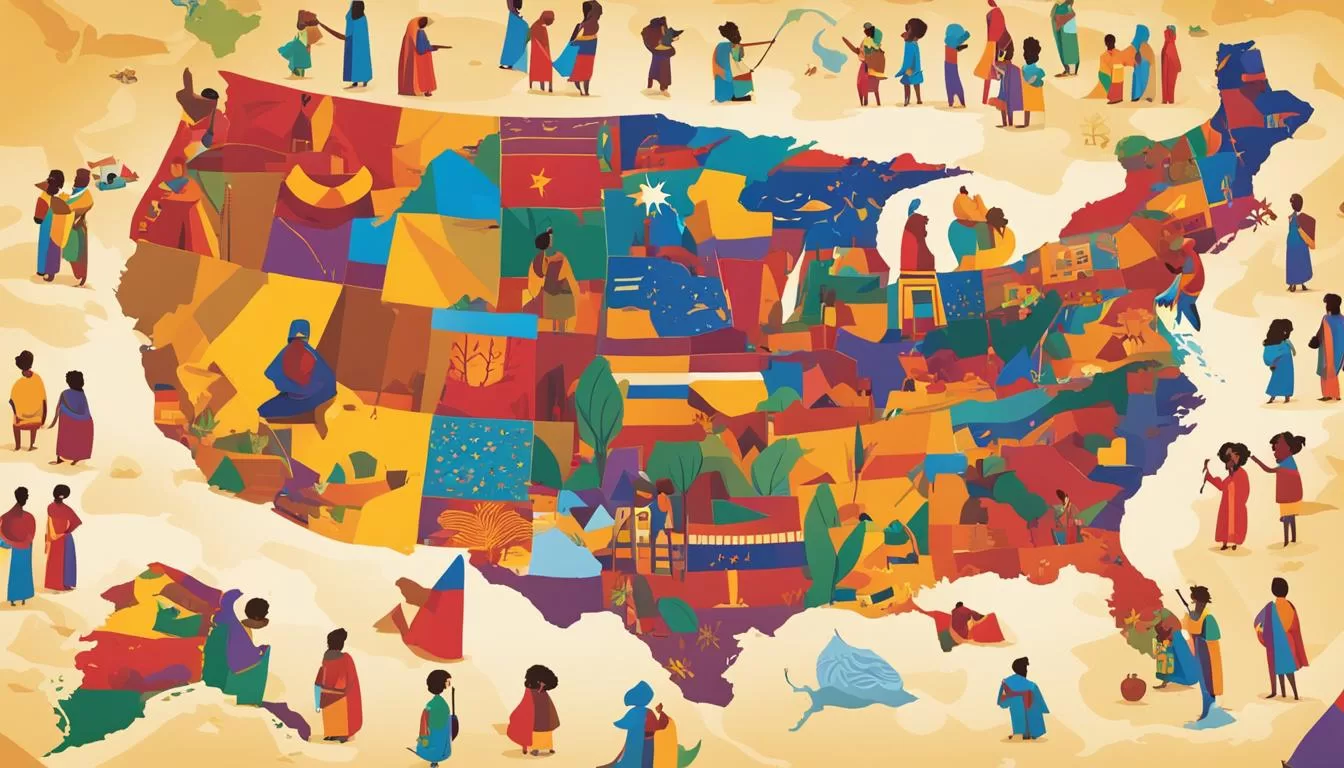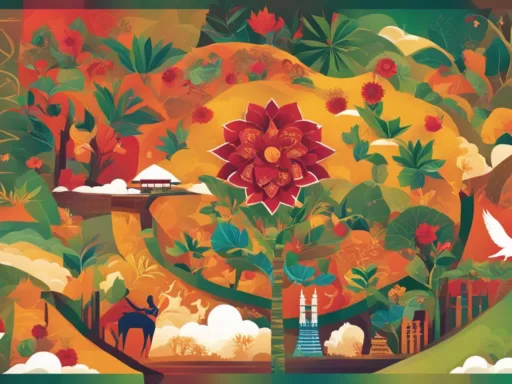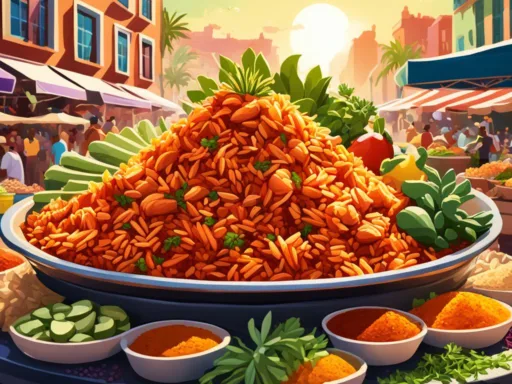The Central African nation of Chad offers a fascinating kaleidoscope of languages, reflective of its rich cultural history and dynamic society. Delving into the linguistic diversity of Chad reveals an intricate web of tongues that serve as a bedrock for communication, trade, and heritage. Officially, Chad recognizes two prominent languages: Arabic and French. Yet, beyond the official discourse, the linguistic diversity of Chad burgeons with over 120 indigenous languages, flourishing within communities and echoing the nation’s multifaceted past.
Among the various languages spoken in Chad, Chadian Arabic emerges as a significant lingua franca, particularly within commerce. Straddling between 40 to 60 percent of the population, its dialectical nuances navigate the chasms between various ethnicities and regions. While French and Modern Standard Arabic have their unique enclaves and applications in educational and administrative domains, even their combined speakership is eclipsed by the pervasive use of Chadian Arabic in daily Chadian life.
As we embark on this exploration of Chadian languages, we journey through the variegated landscape of dialects and vernaculars that contribute to the nation’s mosaic of expression. From the busy streets of N’Djamena to the more secluded corners of the nation, language continues to be an identity marker, a conduit for cultural exchange, and a testament to Chad’s enduring diversity.
Key Takeaways
- Chad is a linguistic nexus with two official languages, Arabic and French, which underscore its historical connections.
- Linguistic diversity in Chad is vast, housing over 120 indigenous languages that paint a rich cultural tapestry.
- Chadian Arabic plays a critical role as the lingua franca, particularly in commerce and everyday communication.
- While official languages have their significance, Chadian languages spoken across the country reflect a deeper communal identity.
- The breadth of languages illuminates the sociolinguistic dynamism inherent in Chad’s populace.
A Glimpse into Chad’s Linguistic Diversity
The heart of Chad’s identity is deeply rooted in its linguistic diversity, with an astonishing array of indigenous languages that paint the social and cultural landscape of the country. At the center stands the Chadian dialect of Arabic, a vibrant lingua franca pivotal to trade and communication, especially in the bustling streets of N’Djamena.
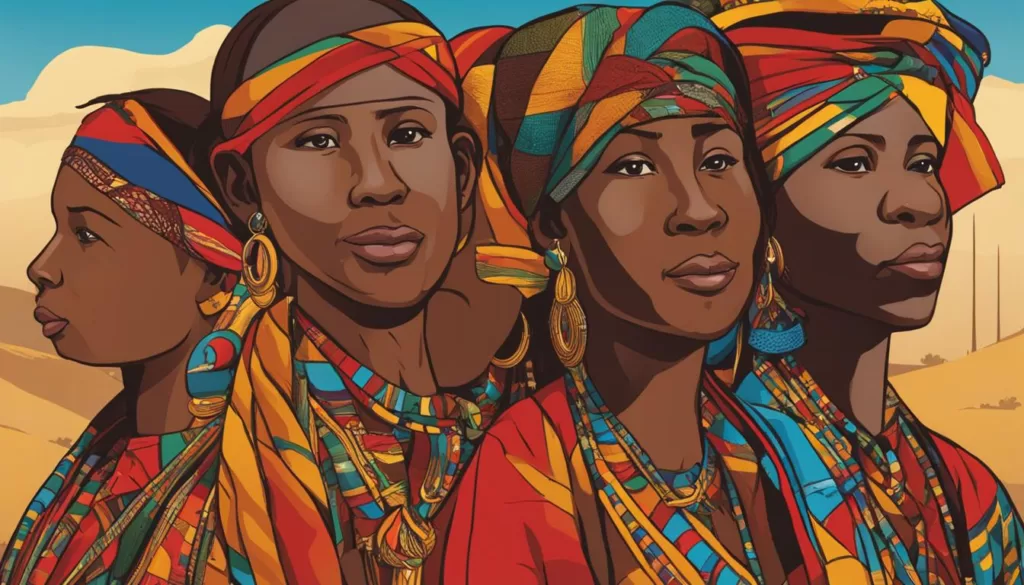
Beyond the widespread use of Chadian Arabic, a multitude of native languages in Chad contribute to the linguistic mosaic of the nation. Ngambay, serving as a prime example, boasts close to one million speakers and stands as a testament to the prevalence of Chadian dialects. But the linguistic tapestry doesn’t end there. Languages such as Maba and Sar offer a glimpse into the nuanced symphony of regional voices.
Another fascinating aspect of Chad’s linguistic repertoire is the array of Bua languages. These tongues, though spoken by fewer individuals, highlight the intricate variations that characterize the indigenous languages of Chad. Let’s look at a breakdown of some prominent Chadian dialects and the number of speakers that keep these languages alive.
| Language | Speakers | Language Family | Notes |
|---|---|---|---|
| Ngambay | Approx. 1 million | Adamawa | Most spoken in the southern region |
| Maba | Approx. 120,000 | Nilo-Saharan | Found in the eastern region |
| Sar | Approx. 183,471 | Nilo-Saharan | Common among the Sara people |
| Bua | Fewer than 30,000 | Niger-Congo | Includes multiple sub-dialects |
This selection of Chadian dialects illustrates only a fragment of the country’s expansive lingual heritage. These indigenous languages of Chad not only function within their respective communities but also contribute to the overall linguistic and cultural richness that defines Chad’s national character.
Chad’s profusion of dialects and languages is a vibrant canvas, not merely of words and grammar, but of stories, histories, and identities interwoven into the very fabric of daily life.
- Chadian Arabic: Dominant trade language and spoken by 40-60% of Chadians
- Ngambay: Vital language in Chad’s southern regions
- Maba and Sar: Reflect the diversity within the Nilo-Saharan language family
- Bua languages: Embody the spectrum of minority languages in Chad
Each language and dialect carries its heritage, echoing the diversity that is so intrinsic to the Chadian experience. As one delves deeper into the story of each tongue, it becomes clear that Chad’s linguistic wealth is an invaluable facet of its cultural identity—a narrative shaped by the voices of its people, from the sands of the Sahel to the banks of the Chari River.
Understanding the Official Languages of Chad
In the realm of official languages of Chad, French and Arabic not only hold a prestigious place but also embody the historical tapestry and modern-day society of this Central African nation. While both languages serve official capacities, their roles and impacts on Chad’s cultural and social spheres are unique and deeply rooted in the country’s colonial past and Arabic heritage.
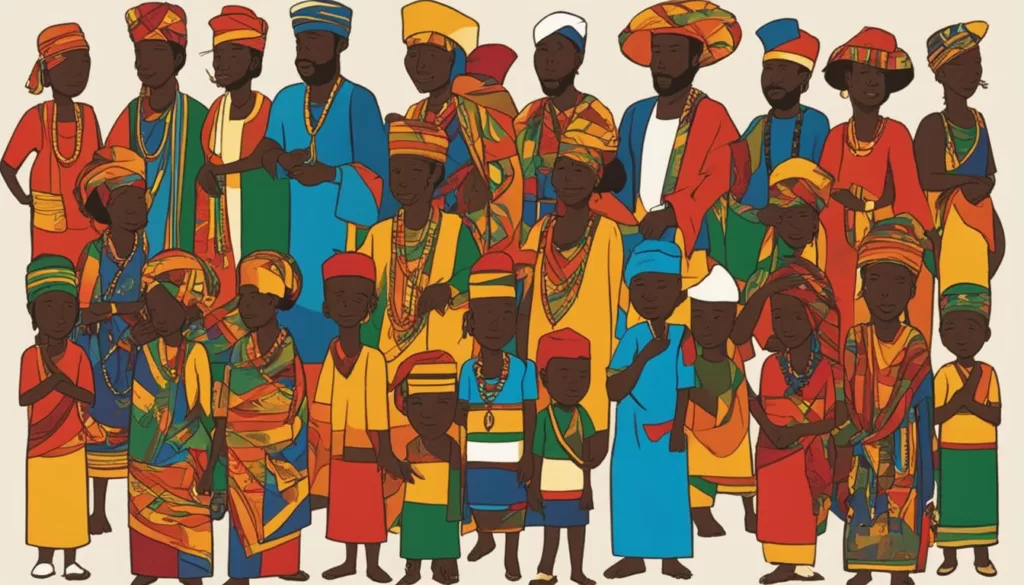
The Role of French in Chadian Society
The legacy of French in Chad, often referred to as French Chad, dates back to the colonial era, leaving an indelible mark on the nation’s educational and administrative endeavors. Today, French serves as the primary language in formal education systems, casting a wide net of fluency, especially prominent among the southern populace and Chadian men. This widespread proficiency ensures that French continues to be a significant vehicle for official discourse throughout the country.
Modern Standard Arabic: Historical and Cultural Influence
Modern Standard Arabic stands alongside French as one of the official languages of Chad, celebrated for its historical and cultural significance. Its usage largely dominates the northern regions, presenting itself as a crucial element in formal communications and media broadcasts. Although it may have fewer speakers compared to the more colloquial Chadian Arabic, it is indisputable that Arabic Chad shapes the multicultural fabric of Chadian society with its profound historical nuances.
The interplay between French and Arabic in Chad not only reflects a bilingual official landscape but also encapsulates the distinct historical paths that have shaped the nation. The adoption and adaptation of these languages have rendered them fundamental to the nation’s identity, each carrying its narrative within the grand tapestry of Chadian culture.
The Importance of Chadian Arabic as the Lingua Franca
Within the dynamic landscape of Chad’s languages, Chadian Arabic stands out for its pivotal role in uniting the nation through trade and interpersonal communication. It is not just one of the major languages spoken in Chad but the very vessel through which the pulse of the Chadian marketplace beats. Whether bartering in the markets of N’Djamena or negotiating deals in the offices of Abéché, Chadian Arabic is the preferred medium of exchange, reflecting its deep-rooted significance in the country’s daily life.
Chadian Arabic: A Unifying Force in Commerce and Communication
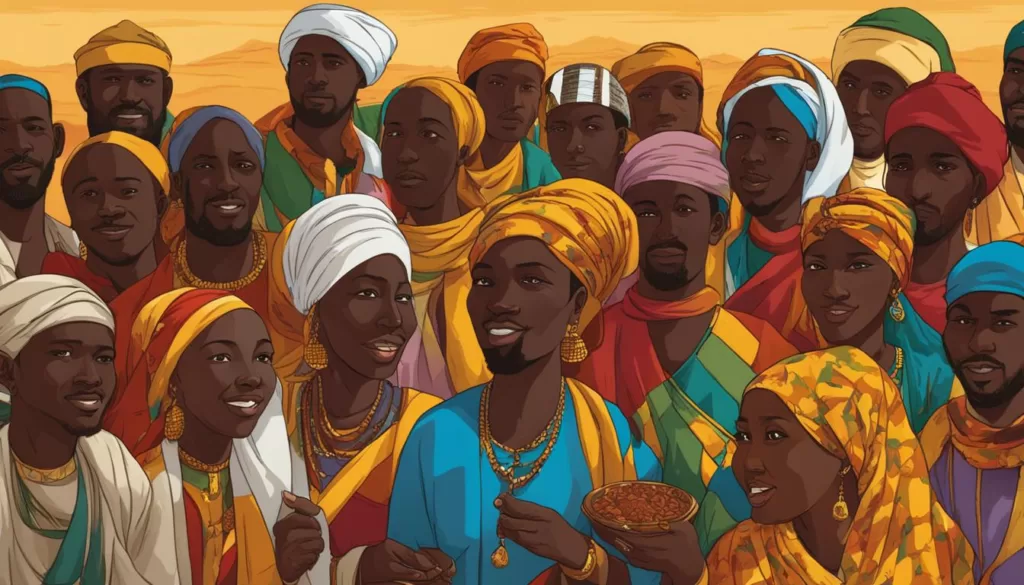
The prevalence of Chadian Arabic is felt across Chad, spoken by a substantial portion of the populace. Estimates suggest that between 40 to 60 percent of Chadians are fluent in this dialect. Drawing on its origins among 17th-century nomadic herders, Chadian Arabic has since evolved and proliferated, bridging ethnic and cultural gaps and fostering a shared identity.
Regional Variations and Influence of Chadian Arabic
One of the outstanding features of Chadian Arabic is its regional diversity. This dialect exhibits adaptability, nuanced by local influences and idioms, thereby facilitating its widespread acceptance across Chad’s multifarious societies. In the southern regions and pivotal urban centers such as N’Djamena, Am Timan, Mao, and Abéché, Chadian Arabic thrives, solidifying its status as the ever-present backdrop to Chad’s sociocultural and economic scenes.
Here’s a closer look at how Chadian Arabic serves various regions:
| Region | Influence | Usage in Sociopolitical Settings |
|---|---|---|
| N’Djamena | Central to commerce | Used in government and business |
| Am Timan | Social interactions | Preferred in marketplaces and schools |
| Mao | Cultural exchanges | Communication across diverse ethnic groups |
| Abéché | Economic activities | Integral to trade negotiations |
The intricacies of Chadian dialects mirror the complex social fabric of this vibrant country. These dialects are not mere tools of communication but embody the enduring spirit and traditions of the Chadian people. In every utterance and transaction expressed through Chadian Arabic, one can discern the nuanced collective identity that is uniquely Chadian.
Languages Spoken Chad: The Rich Tapestry of Indigenous Languages
The linguistic landscape of Chad is a vibrant testament to its cultural diversity. With over 120 distinct indigenous languages Chad is home to, each tells a story of the people and their heritage. These languages, ranging from Chadic to Bongo-Bagirmi, to Maban, and beyond, form a rich tapestry that is as intricate as it is ancient. Within this multitude, particular emphasis is placed on the minority languages of Chad, which, while lesser-spoken, contribute significantly to the cultural mosaic of the nation.
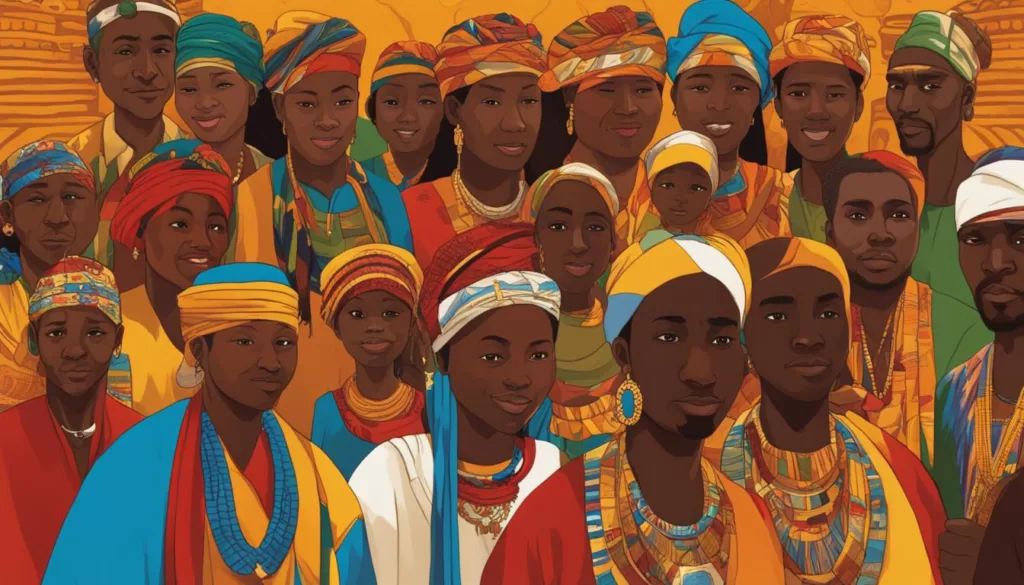
One of the standout languages is Sar, specifically its dialect Ngambay, accruing a significant one million first-language speakers—predominantly Sara people and underscoring the complexity of Chadian linguistic heritage. Yet, Sar and Ngambay are but the tip of the iceberg in a sea of lexical variety. Here’s an illustrative snapshot of the indigenous languages spoken in Chad and their unique characteristics:
| Indigenous Language | Speaker Count | Language Family | Regional Presence |
|---|---|---|---|
| Ngambay | Approx. 1 million | Sara-Bagirmi | Primarily spoken by Sara people in the South |
| Maba | Approx. 120,000 | Nilo-Saharan | Eastern Chad |
| Bua | Less than 30,000 | Niger-Congo | Scattered across rural regions |
| Massalit | Approx. 50,000 | Nilo-Saharan | Located in the Darfur region bordering Sudan |
It is vital to recognize that the exact number of speakers can be challenging to ascertain due to the nomadic nature of some ethnic groups and a lack of comprehensive linguistic surveys in certain remote areas. Additionally, the pressures of globalization and modernization are impacting the transmission of these tongues to younger generations. Despite these challenges, the indigenous languages of Chad continue to flourish, each serving as a living archive of the nation’s storied past and present.
- Saharan languages like Tedaga and Dazaga connect speakers to the Sahara’s expanse.
- In the savannas, the Fur languages, despite small numbers, persist with cultural tenacity.
- The Bongo-Bagirmi languages meld a confluence of ethnolinguistic groups that have thrived for centuries.
- Maban and Eastern Sudanic languages echo across the eastern frontiers, reverberating tales of trade and tradition.
The diverse indigenous languages of Chad are not merely modes of communication; they are the bearers of ancestry, the shapers of identity, and the guardians of a multilingual legacy that resonates through the heart of Africa.
This intricate web of indigenous languages Chad bolsters is not just intellectually fascinating; it’s a call to action for preservation. As globalization encroaches, the importance of protecting these linguistic heritages becomes ever more critical. Chad’s multitude of languages, with their complex etymologies and cultural significances, offer an invaluable window into the human experience—making the conservation of each one an imperative for both national identity and global heritage.
Conclusion: Celebrating the Linguistic Mosaic of Chad
Within the heart of Central Africa lies a linguistic panorama as varied as the land itself. Chad’s impressive linguistic portfolio is a testament to its history—a complex heritage of cultures, traditions, and languages. Intersecting through the bustling marketplaces and quiet rural expanses are the languages spoken in Chad, connecting people in a nation that refuses to be linguistically pigeonholed. A lingua franca such as Chadian Arabic navigates daily life, serving as a unifier for the myriad communities that call this country home.
The substantial roster of Chadian languages speaks to the country’s vibrant past and the ongoing story of its people. From the scholarly pursuits upheld in French to the media broadcasts in Modern Standard Arabic, these official tongues underscore the educational and communicative fabric of Chadian society. Nevertheless, echoing even louder is the chorus of over 120 indigenous languages, each a strand in the greater web of linguistic heritage of Chad, showcasing the vast human tapestry that inhabits these lands.
As we sift through the lexicon of this African nation, we are reminded that its linguistic diversity is not simply an academic curiosity but an integral element reflecting its identity on the global stage. Chad’s wealth of words, phrases, and idioms, from the classrooms of N’Djamena to the oral traditions of remote villages, ensures that its multifaceted linguistic heritage continues to flourish as a pillar of cultural richness and human connection.
FAQ
What languages are spoken in Chad?
Chad is home to a vibrant mix of languages. Arabic and French are the official languages of Chad. In addition to this, over 120 indigenous languages are spoken across the country, including Chadian Arabic as a lingua franca, especially in commerce and day-to-day communication.
Can you give a glimpse into Chad’s linguistic diversity?
Chadian linguistic diversity is immense, with the presence of numerous indigenous languages that reflect Chad’s complex cultural fabric. These languages belong to different language families such as Afro-Asiatic, Niger-Congo, and Nilo-Saharan, and include dialects of Chadian Arabic, Sara, Ngambay, Maba, and many others.
What is the role of French in Chadian society?
French plays a significant role in Chad’s official administration and education systems. It’s the primary medium for formal instruction, making it widely spoken, especially in urban areas and by those who have gone through formal education.
How does Modern Standard Arabic influence Chad culturally and historically?
Modern Standard Arabic in Chad is indicative of historical ties and cultural linkages with the Arab world. It’s used in formal communication, education, and by the media, highlighting its prominence particularly in the north of Chad.
Why is Chadian Arabic considered the lingua franca?
Chadian Arabic functions as a common language that facilitates trade and daily communication among distinct ethnic and linguistic communities across the country. Its prevalence in urban centers and widespread fluency make it a unifying force within Chad.
Are there regional variations in the way Chadian Arabic is spoken?
Yes, regional variations of Chadian Arabic reflect its adaptability to local cultures and ethnic groups. Its prominence is noted in the southern region around N’Djamena, Am Timan, Mao, and Abéché, exhibiting unique characteristics in pronunciation and vocabulary.
What are some of the indigenous languages found in Chad?
Among the numerous indigenous languages in Chad, some of the more spoken ones include Ngambay, Sar, Massa, and Moundang. However, there are many other languages with smaller groups of speakers which contribute to the country’s rich tapestry of linguistic heritage.
How many people speak the official languages of Chad?
While there are no precise numbers, a significant portion of the Chadian population is bilingual in French and Chadian Arabic. Chadian Arabic is spoken by an estimated 40-60% of the population, acting as a common language for many Chadians. French, as the language of education and administration, has a widespread proficiency, particularly in the south and among educated individuals.

